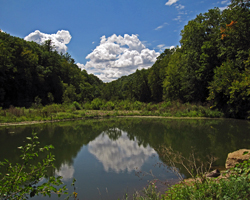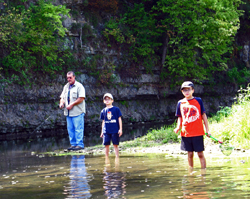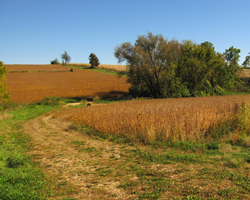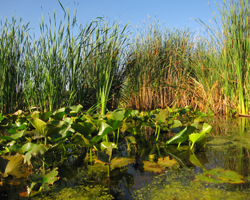Landscape of Instructional Technology
Students visually interact with the land, highlight boxes raise questions about what they are seeing.
Eureka!
I recently created online courses designed to train Conservation Reserve Program professionals to conduct environmental evaluations with an eye towards natural resource concerns. The challenge was to engage and immerse students within the flow of the land and its physical inter-relationships. There just had to be a better way than showing slide after slide in PowerPoint.
After some research and experimentation I mastered a program that incorporates digital photographs. Learners can now cross the divide from the classroom to the field. Students using OS-independent desktop or mobile devices explore the land with their own eyes while learning how to conduct environmental evaluations. What you will find below is the proof of concept with a real-world example.
Case: The Driftless Area Initiative
The primary purpose of the Driftless Area Initiative is to restore, improve and protect fish and wildlife habitat for the unique and diverse species found in the region's working lands, forests, streams and prairies. To immerse the audience in the land, Photosynths are utilized providing pan, zoom-in, zoom-out and highlight boxes which scaffold and guide the experience. In a series, students are taken from the top of a watershed through the streams, creeks and ultimately into a major river. Along the way students learn about adequate conservation buffers between fields and waterways and questions are raised via highlight boxes. Combined, they bring the student to the land and create a connection between conservation practices and water quality
Top of the Watershed
Beneath the grass cover a cold, spring-fed stream is protected with perennial cover and buffered from crops. The land in Jo Daviess County, IL is part of the Driftless Zone where NRCS targets trout streams and ways to enhance the water quality.
Further Downstream
Plum Creek in the Driftless Region of Northwest Illinois joins the Apple River where they flow into the Mississippi River. The Apple River Canyon State Park is just 3 miles away.
Apple River
The Apple River watershed in the Driftless Region receives water from Plum Creek. Thanks to USDA and NRCS Programs the waters run clean, clear and cool to help fish and wildlife thrive. The people like it, too.
These are just a few brief examples and the technology can be used at the macro and micro level.
~ Fifteen years of client and staff training
~ Particular emphasis on use of Internet technologies for collaborative learning.
Click here to see my resume.
Originally from Evanston, Ilinois I have been enjoying the good life in Madison, WI since 1993.




